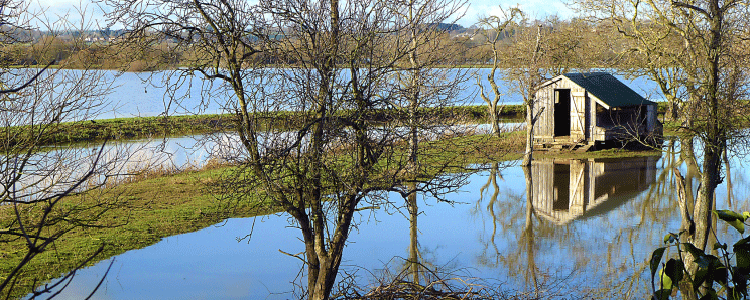
The visit of the Environment Secretary to the flooded areas of the Somerset levels is a response to the duration and extent of the flooding. The flooding started before Christmas and with more rain forecast, does not appear to be abating any time soon.
There were floods last year, too. The Environment Agency described those floods (less severe than the current inundation) as a “100-year flood”. Presumably two in a row is a “10,000-year” flood event? Or perhaps the probability of occurrence isn’t a 1-in-10,000 (as local residents are suggesting) and more positive and long-term action is required.
Additional pumps have been brought into the area, and are pumping ten tonnes of water per second into the river Parrett.
The area between Bridgwater, Wedmore, Baltonsborough and Curry Rivel forms (within a bit) a square with sides ten miles long. If an inch of rain falls in that square (and that has happened a few times recently) it weighs 6.5 million tonnes – which at ten tonnes per second, will occupy the emergency pumps for almost 11 weeks running 24/7. That’s until mid-April. For that one inch of rain.
So when do we need a project, and when can we manage with business-as-usual activities? Business-as-usual used (until 18 years ago) to include dredging the Parrett and Tone rivers, but this was discontinued on the grounds of being not cost-effective. The reality is that there are no hard and fast rules for deciding whether a project is required. The risk (and therefore cost) of relying on business-as-usual activities (which in this case includes emergency pumping) is presented in sharp focus in the media, and is clearly regarded as unacceptable by residents. This implies that a project (perhaps to specify and let a dredging contract, but there are no doubt many proposals and even more opinions) would be required to bring about a new, more acceptable business-as-usual state that can be maintained by business-as-usual activity. We should expect that some form of stakeholder engagement exercise will take place in order to identify and consider the many options that will be put forward.
The cost of cleaning up should give an indication of the size of the budget, but this will probably be a weaker link than would be expected in a more commercial project environment, as it involves quality of life as well as bank balance.
The political aspects bring other forces to bear. Even if the Meteorological Office is completely certain that the odds are 1 in 100 that such events occur in any one year, the odds of now having three in a row – flooding next winter – are 1 in 100, and if no action is taken, and it floods again, ministerial (and meteorological?) heads might roll. The ‘do nothing’ option may very well not be an option, even if no effective action can be afforded. It may be that a number of measures are identified as being required (trapping water on higher ground, more pumping stations, better water-flow gauging, dredging, etc.) and the Environmental Agency will structure and implement a programme of work.
Latest posts by Hilary Small (see all)
- Flood responses – Business as usual, project, or something bigger? - 28 January, 2014









